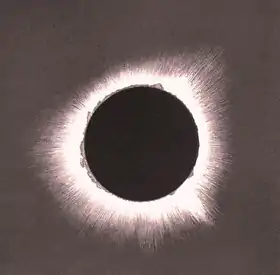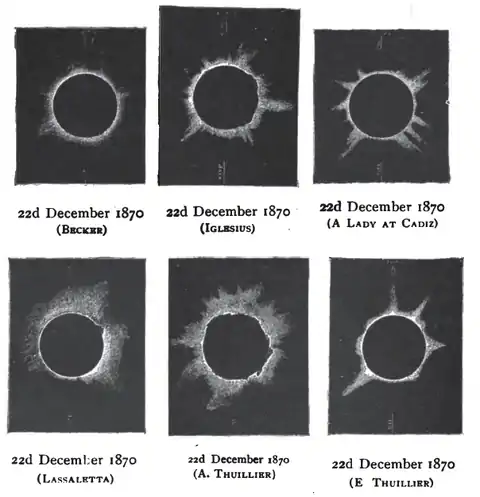Solar eclipse of December 22, 1870
A total solar eclipse occurred on December 22, 1870. A solar eclipse occurs when the Moon passes between Earth and the Sun, thereby totally or partly obscuring the image of the Sun for a viewer on Earth. A total solar eclipse occurs when the Moon's apparent diameter is larger than the Sun's, blocking all direct sunlight, turning day into darkness. Totality occurs in a narrow path across Earth's surface, with the partial solar eclipse visible over a surrounding region thousands of kilometres wide. Totality was visible from southern Portugal and Spain, across northern Algeria, then crossing Sicily, Greece, Bulgaria, and ending in the south-west of the Russian Empire.
| Solar eclipse of December 22, 1870 | |
|---|---|
 Map | |
| Type of eclipse | |
| Nature | Total |
| Gamma | 0.8585 |
| Magnitude | 1.0248 |
| Maximum eclipse | |
| Duration | 131 sec (2 m 11 s) |
| Coordinates | 35.7°N 1.5°W |
| Max. width of band | 165 km (103 mi) |
| Times (UTC) | |
| Greatest eclipse | 12:27:33 |
| References | |
| Saros | 120 (53 of 71) |
| Catalog # (SE5000) | 9213 |
Related eclipses
It is a part of solar Saros 120.
References
- NASA chart graphics
- Googlemap
- NASA Besselian elements
- Mabel Loomis Todd (1900). Total Eclipses of the Sun. Little, Brown.
- Reports on observations of the total solar eclipse of December 22, 1870 By United States Naval Observatory, Simon Newcomb, Asaph Hall, William Harkness, John Robie Eastman
- Solar Eclipse seen from Jerez in 1870
- The sun was crowned in Jerez
Wikimedia Commons has media related to Solar eclipse of 1870 December 22.
This article is issued from Wikipedia. The text is licensed under Creative Commons - Attribution - Sharealike. Additional terms may apply for the media files.


.jpg.webp)

